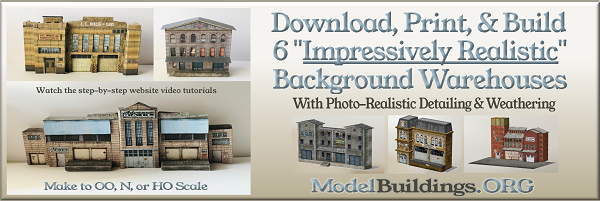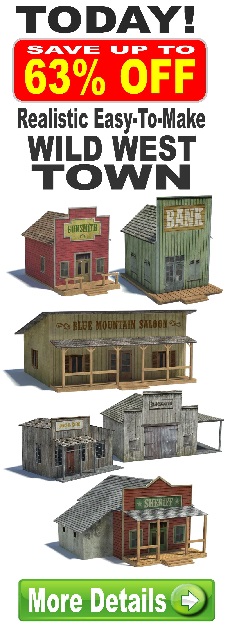Everything on model trains, model railroads, model railways, locomotives, model train layouts, scenery, wiring, DCC and more. Enjoy the world's best hobby... model railroading!
Turnouts and LED Lighting
Frank has some questions for readers:
Hello everybody, fairly new to model railroading (had Plywood Summit Lines layout for over 20 years when father built it when I was a kid), but I’ve seen a major advance in technology since the layout was first constructed. I’m looking to start the Oregon Pass Lines, and here’s where the questions come up:
- On HO turnouts, would it be easier running above table switches for the yard, and under table switches for mains? Or leave them all above table? Tortoise available?
- Regarding turnouts, I’ve got a general idea for my control panel, but I’d like to use toggle switches instead of the Atlas switch. Is it possible to add a 3mm LED into the equation for each leg? I’d like to be able to tell which way the train goes
- If I’m using the Atlas turnouts, basically same as #2, can I add an LED to the panel, if I run the Atlas switch as well? (2nd choice if toggle isn’t an option)
Thanks for any and all help.
4 Responses to Turnouts and LED Lighting
Leave a Reply
















Hi Frank,
Here is how I am working my switches. I am setting main line switches and I am using as you call under the table tortoise switch motors. In the yards where it is not as important to switch the switches a head of an operating train most of us will use Caboose Hobby manual switch throws where you reach to the switch and turn the handle. Something I am doing is installing household electric light switches in the blue plastic electric boxes and mount them under your switch and run a wood dowel rod to the edge of the table for a push pull control. If you modify it with a household 3 way switch you have s circuit using the 3 contacts to either feed and power the frog, or like you say have indicators to show which way your switch is thrown, I am personally building my own switches myself and installing them on the main level But i have 31 atlas number 6 switches all over the staging level. Nothing wrong with atlas switches but I recommend getting out of number 4 switches as most long cars and engines do not like them as they are too sharp. .I assume you are still running DC. But as you wire your new layout wire it to be DCC ready as the thing now is powering with DCC systems and running computer chipped engines. It is more realistic and actually the wiring is is simpler and more dependable. As far as Question 3 The tortoise has 2 separate circuits to wire signals to the panel or as I am planning to do to mine is wire LED Dwarf signals on each direction of a switch and wire the green from one direction with a red for the other direction and when the switch is thrown the colors switch to the other track You can als link these into a control panel as well. Be sure to use the resisters with the LED Bulbs. If you wire your new layout to work for DCC systems this will ensure lots of connectins along your tracks every 4 to 8 feet aparts is recommended. This uses a Buss Wire system that just follows your rails and you install a drop wire to the rails above every 4 to 8 feet. This reduces power droppage along your route. I use Number 16 gauge trailer wire or better for your buss wires and I use phone house wire for my drops. If you are powering multiple tracks you might want to follow each rail with a different color wire to keep them straight. The plans for the house hold electric manual switchplans were found in an article of Model Railroader in about a January issue of Model Railroader magazine about 4 years ago ( without going back and looking. I have installed 4 on my layout so far and they work great. The cost in materials is only about 3 dollars and a little work. The plans call for a standard on/off switch and that will work but a 3way switch will give you the circuit to light the signal lights like you want or power the frog. (do not get a switch that is a dimmer as these are not spring loaded. The nice thing about them is that the electric switch is a spring loaded switch and will hold the rail switch in place when thrown. Unlike atlas switch motors where some will drift and cause derailments. A Tortoise motor can be 18 to 20 dollars,and it has 2 extra circuits, where the atlas are usually a snap switch motor and will need a momentary switch to operate and those will run 12 dollars or so. That electric switch I was telling you about is only about 3 dollars or so im materials. Just Saying…. Hope this helps from Newman
It does help Newman, thank you. I’ve been doing a lot of research between turnouts, under the table switches, and the Tortoise switches. With the setup I have, which is actually 7×14 ft., but I negotiated for the extra room to build the Oregon Pass, and No. 4 turnouts aren’t avoidable. But 25% of me is still trying to figure out if I want to go that route, or freelance, which I have been testing using SCARM. If I went the OPL route, Tortoise wouldn’t really be an option due to height between track levels. But basically trying the same thing you are, just different switches. I forgot to mention before, but yes I am currently running DC, even thought about going DCC, but that still isn’t in the budget quite yet. I was thinking of staying with Atlas switches, just have to keep researching which path I want to go. But thanks again for the help, it gives me a better idea of wiring it up.
Frank
Franks I want to mention that some of my tortoises I mounted on the front edge of the module for the same reason of not enough space between levels. I am now building removable rock formations to cover these switch motors They act as a cover for the motors, access to work on them or add signal circuitry later and in the curves they act as a catch in case of derailments to keep the trains from going on the floor So far so good I have included a pic of the switch motors and the cover rock formation still in the works. from Newman
Frank Here is the switch motors on the front side of the tracks that this rock cover is hiding and protecting
This is what is under these rocks from Newman